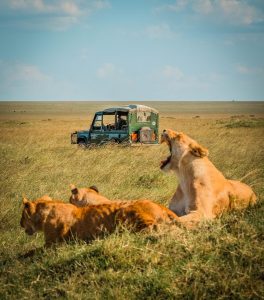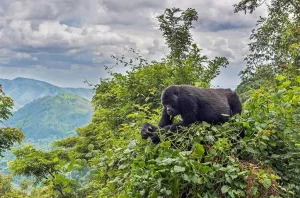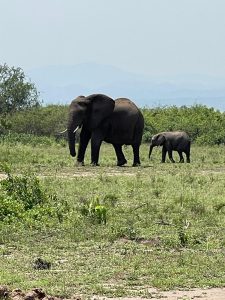Where is Chobe National Park located?
Chobe National Park is located in northern Botswana, near the borders with Zambia, Zimbabwe, and Namibia. It covers approximately 11,700 square kilometers, making it one of the largest and most diverse national parks in Southern Africa. The park is divided into four main regions: Chobe Riverfront, Savuti, Linyanti Marshes, and the dry hinterland. Each area offers unique landscapes and wildlife experiences, making the park an exceptional safari destination. A Guide to Chobe National Park Safari
Why is Chobe National Park famous for safaris?
Chobe National Park is world-famous for its massive elephant population. It is estimated that over 120,000 elephants live in the park, the highest density of elephants anywhere in the world. Visitors often see herds of hundreds gathering along the Chobe River, particularly during the dry season. In addition to elephants, the park is known for its high concentration of lions, leopards, buffaloes, and diverse birdlife. The combination of wildlife, varied landscapes, and excellent accessibility makes Chobe a top safari destination. A Guide to Chobe National Park Safari
What wildlife can you see in Chobe National Park?
Chobe National Park supports an extraordinary variety of wildlife. Large mammals include elephants, buffaloes, zebras, giraffes, lions, leopards, and spotted hyenas. Wild dogs and cheetahs also roam the savannas, though sightings are less frequent. The Chobe Riverfront attracts large herds of elephants, buffaloes, and antelopes during the dry season. Hippos and crocodiles are common along the riverbanks, while Savuti is famous for predator interactions, especially lions hunting elephants during extreme droughts. The diversity of ecosystems allows visitors to see a wide range of species in a single trip. A Guide to Chobe National Park Safari
When is the best time to visit Chobe National Park for a safari?
The best time to visit Chobe National Park is during the dry season from May to October. During this period, animals gather around the Chobe River and waterholes, providing excellent game-viewing opportunities. The vegetation is thinner, making it easier to spot wildlife. The wet season, from November to April, transforms the park into lush green landscapes and is the best time for birdwatching. However, some roads may become difficult to access during heavy rains. Travelers should choose their visit based on whether they prioritize big game sightings or birdlife. A Guide to Chobe National Park Safari
What safari activities are available in Chobe National Park?
Chobe National Park offers a wide range of safari activities. Popular options include game drives, boat cruises, birdwatching excursions, and guided walking safaris. Each activity provides a unique perspective of the park. Game drives allow visitors to explore the savannas and woodlands, while boat cruises along the Chobe River provide close-up views of elephants, hippos, and crocodiles. Some operators also offer photography safaris, cultural village visits, and fishing trips. The diversity of activities makes Chobe an appealing destination for different types of travelers.
How popular are boat cruises on the Chobe River?
Boat cruises on the Chobe River are among the most popular activities in the park. These cruises offer an opportunity to see elephants swimming across the river, hippos lounging in the water, and crocodiles basking on the banks. The cruises also provide excellent birdwatching, with sightings of African fish eagles, kingfishers, and herons. Sunset cruises are especially popular because they combine wildlife viewing with breathtaking views of the sun setting over the water. Many visitors consider the Chobe River cruise the highlight of their safari experience.
Can you do game drives in Chobe National Park?
Yes, game drives are the most common safari activity in Chobe National Park. Morning and late afternoon drives are the most productive times for spotting wildlife, especially predators such as lions and leopards. Game drives can be conducted in open safari vehicles, providing excellent visibility for photography and wildlife observation. Visitors can join group drives organized by lodges or hire private guides for a more personalized experience. Night drives are not permitted within the park boundaries, but some private concessions nearby offer this option.
What bird species can be spotted in Chobe National Park?
Chobe National Park is a paradise for birdwatchers, with more than 450 bird species recorded. The park is home to African fish eagles, marabou storks, carmine bee-eaters, African skimmers, and yellow-billed storks. During the wet season, migratory birds arrive, adding to the diversity. The Chobe Riverfront and Linyanti Marshes are particularly good locations for birdwatching. Specialist birding tours are available, ensuring visitors can maximize their chances of spotting rare and interesting species.
How long should a Chobe National Park safari last?
The ideal duration for a Chobe National Park safari is three to five days. This allows visitors to explore different regions of the park, including the Chobe Riverfront and Savuti. A shorter visit may still provide memorable experiences, but a longer stay increases the chances of seeing a wider variety of wildlife and participating in multiple activities. Many travelers combine Chobe with nearby destinations such as Victoria Falls or the Okavango Delta for a more extensive safari experience.
What types of accommodation are available near Chobe?
Chobe offers a wide range of accommodation options, from luxury lodges to budget-friendly campsites. Most lodges and hotels are located in Kasane, the gateway town to Chobe National Park. Luxury lodges offer riverfront views, fine dining, and guided safari activities, while mid-range lodges provide comfortable stays at affordable prices. For adventurous travelers, camping inside or near the park is also an option. Houseboats on the Chobe River provide a unique way to combine accommodation with safari activities.
How do you get to Chobe National Park?
The easiest access point to Chobe National Park is through Kasane, which has a small international airport. Kasane is well connected by road to Zambia, Zimbabwe, and Namibia. Visitors often combine a Chobe safari with trips to Victoria Falls, which is only about 70 kilometers away. Flights to Kasane are available from major hubs such as Johannesburg and Maun. Once in Kasane, visitors can easily enter the park for game drives or boat cruises.
Is Chobe National Park safe for tourists?
Yes, Chobe National Park is safe for tourists. Safari operators and guides follow strict safety protocols, and visitors are always accompanied by experienced professionals. The main risks are related to wildlife encounters, but guides ensure that guests keep a safe distance from animals. Visitors should also take precautions against malaria by using insect repellent and sleeping under mosquito nets. By following the rules and listening to guides, travelers can enjoy a safe safari experience.
Can you combine a Chobe safari with Victoria Falls?
Yes, combining a Chobe safari with a visit to Victoria Falls is very popular. The falls are located on the border of Zambia and Zimbabwe, only a short drive from Kasane. Many tour operators offer packages that include both destinations, allowing travelers to enjoy a river and wildlife safari in Chobe before experiencing the power of the world’s largest waterfall. This combination provides a complete adventure in Southern Africa.
How much does a Chobe National Park safari cost?
The cost of a Chobe National Park safari depends on the type of accommodation and activities chosen. Budget travelers can expect to pay around $100 to $200 per day, including camping and shared activities. Mid-range safaris range between $300 and $500 per day, while luxury packages can exceed $700 per day. Costs typically include accommodation, meals, park fees, and activities such as game drives and boat cruises.
Do you need a guide for safaris in Chobe National Park?
Yes, safaris in Chobe National Park require guides. Professional guides have expert knowledge of wildlife behavior, park regulations, and safety procedures. They also enhance the safari experience by spotting animals that visitors may miss. While self-drive safaris are technically possible in some areas, hiring a guide is strongly recommended for safety and a richer experience.
What conservation efforts protect wildlife in Chobe?
Chobe National Park plays a critical role in regional conservation. Botswana has strict anti-poaching policies, and the government invests heavily in wildlife protection. Conservation organizations work alongside park authorities to monitor elephant populations, manage human-wildlife conflicts, and preserve habitats. Tourism revenue contributes directly to conservation efforts, making every safari a valuable contribution to protecting the park’s ecosystems.
Can families with children visit Chobe National Park?
Yes, families with children can visit Chobe National Park. Many lodges welcome families and offer child-friendly activities such as short game drives or educational programs. However, some lodges may set age restrictions for activities like walking safaris or boat cruises for safety reasons. Parents should confirm child policies when booking. Chobe’s abundance of wildlife and accessible activities make it an exciting destination for family safaris.
Are night drives allowed in Chobe National Park?
Night drives are not permitted inside Chobe National Park. However, private concessions surrounding the park may offer night drives. These safaris provide opportunities to see nocturnal animals such as leopards, hyenas, and bush babies. Visitors interested in night drives can book lodges located in private reserves near the park.
What should you pack for a Chobe National Park safari?
Travelers should pack light, breathable clothing, a wide-brimmed hat, sunscreen, insect repellent, sturdy shoes, and a good camera. Binoculars are essential for birdwatching and spotting animals from a distance. Warm clothing is recommended for early morning drives, as temperatures can be chilly. A reusable water bottle is also useful for staying hydrated during activities.
Why should you choose Chobe National Park over other safari destinations?
Chobe National Park offers one of the most complete safari experiences in Africa. Its massive elephant herds, abundant predators, and birdlife provide unmatched wildlife viewing. The park’s accessibility from Victoria Falls makes it easy to combine with other regional attractions. The variety of safari activities, from boat cruises to game drives, ensures that every visitor enjoys a diverse and memorable experience. For these reasons, Chobe stands out as a premier safari destination in Southern Africa. A Guide to Chobe National Park Safari




